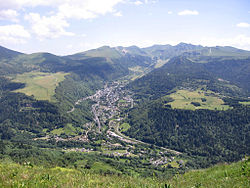Armero aftermath Marso
An explosive eruption from Ruiz's summit crater on November 13, 1985, at 9:08 p.m. generated an eruption column and sent a series of pyroclastic flows and surges across the volcano's broad ice-covered summit. Pumice and meltwater produced by the hot pyroclastic flows and surges swept into gullies and channels on the slopes of Ruiz as a series of small lahars. Flowing downstream from Ruiz at an average speed of 60 km per hour, lahars eroded soil, loose rock debris and stripped vegetation from river channels. By incorporating water and debris from along river channels, the lahars grew in size as they moved away from the volcano--some lahars increased up to 4 times their initial volumes.
Within four hours of the beginning of the eruption, lahars had traveled 100 km and left behind a wake of destruction: more than 23,000 people killed, about 5,000 injured, and more than 5,000 homes destroyed along the Chinchiná, Gualí, and Lagunillas rivers. Hardest hit was the town of Armero at the mouth of the Río Lagunillas canyon, which was located in the center of this photograph. Three quarters of its 28,700 inhabitants perished.
(Amalgamation of sentences taken verbatim from source.)Relevante Bilder
Relevante Artikel
LaharEin Lahar ist ein Schlamm- und Schuttstrom, der von einem Vulkan ausgeht. Das Wort kommt aus dem Javanischen. Dabei mischt sich eruptives Material aus zum Teil metergroßen Blöcken mit Lockersedimenten und Wasser. Je nach Geländeneigung können Lahars durch die Schwerkraft eine Geschwindigkeit bis zu 100 km/h erreichen, über 100 km weit fließen und große Gebiete überschwemmen. Sie können durch einen Vulkanausbruch ausgelöst werden, aber auch völlig unabhängig davon entstehen. Je nach Art ihrer Entstehung können Lahars bis zu 100 °C heiß sein. .. weiterlesen



